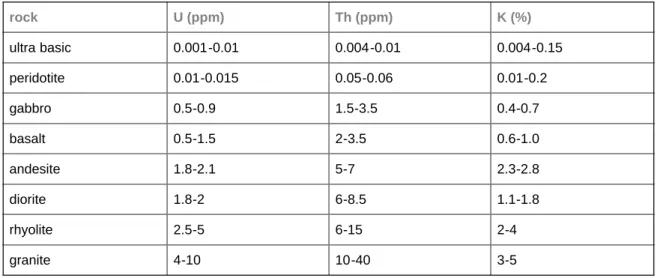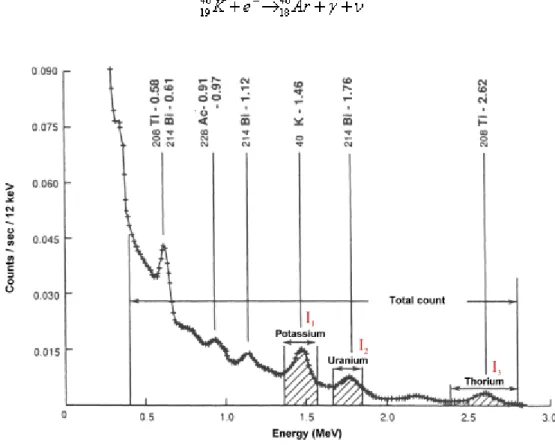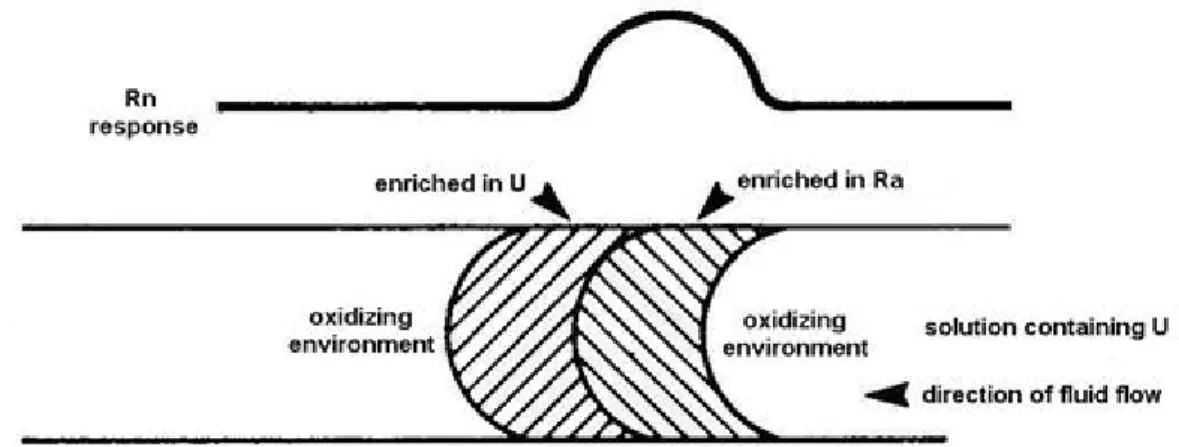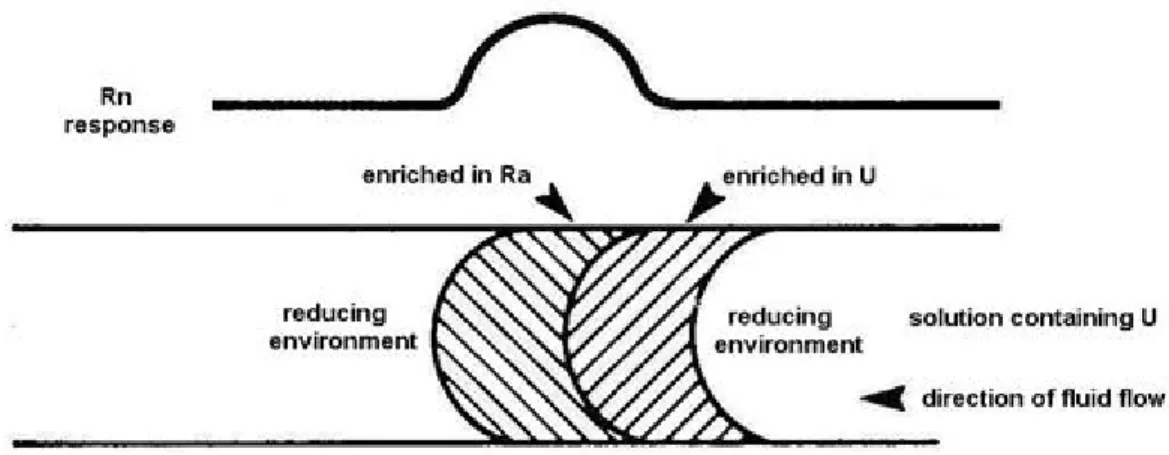P
ethőG
ÁBOR, V
ASSP
ÉTER,
G EOPHYSICS
2
II. R
ADIOMETRIC METHODS1. S
HORTHISTORYOFRADIOMETRYWilhelm Conrad Roentgen (1845 – 1923)
Roentgen discovered X-rays in 1895 and in the next year Becquerel observed natural radioactivity.
Thomson discovered electrons in 1897. In the years 1899 and 1900 Rutherford and Villard distinguished between ionizing radiations on the basis of ionizing power and the three types of radiation were simply named alpha, beta and gamma, for the first three letters of the Greek alphabet. Villard recognized that gamma rays were emitted from radioactive substances and they were different from X-rays because gamma rays had a much greater penetrating depth. Becquerel realized (in 1899) that the beta particle was identical with the electron discovered by Thomson. It was only later that alpha radiation was shown to consist of helium nuclei by Rutherford and Royds (1909).
Ernest Rutherford (1871 – 1937)
The formulation of the radioactive decay law was given by Rutherford and Soddy in 1902. They recognised that the rate of decay of a radioactive isotope depends on the amount of the parent isotope remaining. It was Rutherford who, in 1904, raised the possibility of using radioactivity to measure geologic time on minerals. He calculated the age of the Earth to be about 500 million years on the basis of helium quantity in uranium minerals in 1905. Boltwood (1907) assumed that lead was the stable end product of the uranium decay series, and he determined a similar age based on the ratio of atomic uranium and lead concentrations. Holmes (1913) concluded on the basis of measured radioactivity that the age of the Earth could be approximately 1,600 million years.
Hans Geiger (1882 – 1945)
The Geiger–Müller counter was invented by Geiger in 1908, and Müller also took part in developing it further in 1928. The first use of a scintillator dates back to the beginning of the last century; however, a photoelectric multiplier was first used only in 1944 by Curren and Baker. Aston built the first full functional mass spectrometer in 1919.
2. P
HYSICALBASISOF RADIOMETRYThere are different types of natural radioactive disintegrations. Negative beta decay can be experienced most frequently (46%), and the ratio of electron capture is also relatively high (25%). The occurrence of additional nuclear disintegrations is relatively low: positive beta decay 11%, alpha decay 10%, and spontaneous fission of heavy isotopes 8%. In the course of these nuclear disintegrations the atomic number always changes, just like the mass number in case of alpha emission and spontaneous fission. The mass number of the new nucleus does not change during beta decays and electron capture.
The most important nuclear disintegrations are given in Table 1. Alpha and negative beta emissions can be only observed during the decay of U, Th and their progenies.
Element Parent isotope
Percent of natural element
Decay mechanism
Stable daughter
Decay constant ( year-1)
Half-life T1/2
(109 year)
U 238U
235U
99.274 0.720
206Pb 207Pb
1.55*10-10 9.85*10-10
4.468 0.7038
Th 232Th 100. 208Pb 4.95*10-11 14.01
Rb 87Rb 27.85 87Sr 1.42*10-11 48.80
K 40K 0.01167 KEC (11%)
(89%)
40Ar 40Ca
5.81*10-11 4.96*10-10
1.25
C 14C 1.6*10-10 14N 1.21*10-4 5.73*10-6
Table 1: Summary of the most common natural nuclear disintegrations
Potassium has only one isotope which is radioactive. It is 40K, which disintegrates in two ways. One process is a negative beta decay:
It is more common (89%) than the K electron capture (11%):
The latter proton-neutron transformation provides the physical base of potassium content determination (from which even clay volume can be determined for U and Th free sedimentary rock) and of K-Ar radiometric dating method. In the last column of Table 1, the half-life values are also presented. 87Rb has the greatest half-life, and 87Sr is produced by the negative beta decay of 87Rb:
For a radioactive series the condition of radioactive equilibrium can be derived from the basic equation of radioactivity. At radioactive equilibrium the number of daughter elements disintegrating per time unit equals the number of daughter elements being produced by the decay of the parent isotope. If Nk denotes the amount of the k-th progeny of the decay series at time t then the rate of decay can be given in the knowledge of the decay constant lk
At the same time the number of atoms of the k-th progeny is being increasing by the disintegrations of its parent:
The total change in the number of daughter elements is:
From the condition of the equilibrium this time derivative has to be zero, i.e.:
For lack of radioactive equilibrium the determination of the amount of parent elements based upon the quantity of daughter atoms cannot be accurate. The condition of the equilibrium can be generalized for a radioactive series as well.
The higher the U, Th or K content of a rock is, the greater its natural radioactivity has to be. Acid magmatic rocks are usually more active than intermediate and basic magmatic rocks. Ultrabasic rocks are characterized by the least natural radioactivity. The natural radioactivity of magmatic rocks increases with the acidity. The data given in Table 2 support this statement. The activity of sedimentary rocks (Table 3) mainly depends on the activity of the deposited sediments and the activity of metamorphic rocks can be
correlated to the radioactivity of the primary rocks. The intensity of surface background gamma radiation is the sum of the gamma radiation emitted by rocks close to the detector and the cosmic gamma radiation.
rock U (ppm) Th (ppm) K (%)
ultra basic 0.001-0.01 0.004-0.01 0.004-0.15
peridotite 0.01-0.015 0.05-0.06 0.01-0.2
gabbro 0.5-0.9 1.5-3.5 0.4-0.7
basalt 0.5-1.5 2-3.5 0.6-1.0
andesite 1.8-2.1 5-7 2.3-2.8
diorite 1.8-2 6-8.5 1.1-1.8
rhyolite 2.5-5 6-15 2-4
granite 4-10 10-40 3-5
Table 2: Uranium, thorium and potassium content of some magmatic rocks
rock U (ppm) Th (ppm) K (%)
limestone 1.5-2 1.5-2 0.2-0.4
sandstone 1.5-2.1 4-11 0.6-1.2
shale 4-6 10-13 2.4-2.7
schist 1.5-4 5-15 0.5-4
Table 3: Uranium, thorium and potassium content of some sedimentary rocks and schist
3. N
ATURALGAMMAMEASUREMENTSIn the practice of applied geophysical radiometry it is the gamma radiation which is utilized due to its larger penetration depth compared with the alpha and the beta radiation. We can make difference between integral and spectral natural gamma measurements. In the course of integral natural gamma measurements the total natural gamma intensity is determined. If natural gamma measurement is made in an energy selective way, the quantitative determination of isotopes emitting gamma radiation is also possible because the energy of the gamma radiation characterizes the isotope itself and from the amplitude of the gamma radiation at the specific energy the content of the isotope can be concluded (see Fig. 1).
Isotope Half-life Type of radiation
238U 4.49×109 yr 234Th 24.1 day 234Pa 1.17 min 234U 2.48×105 yr 230Th 7.7×104 yr 226Ra 1600 yr 222Rn 3.82 day 218Po 3.05 min
214Pb 26.8 min 214Bi 19.8 min
214Po 162 µsec 210Pb 22.3 év 210Bi 5.01 day 210Po 138.4 day 206Pb stable .
Table 4: 238U radioactive (main) series
The most important aim of a radioactive survey is uranium exploration. In geological mapping the knowledge of the U, Th and K content can be also very informative, because the natural radioactivity of magmatic rocks tends to increase with SiO2 content. The effusive rocks are generally more active than their intrusive equivalents. In the case of sedimentary rocks the U, Th and K content can be correlated to the depositional environments. The radioactive potassium isotope, with an atomic weight of 40, and the radioactive elements of uranium and thorium series emit nearly all the natural gamma radiation. The occurrence of 238U (99.274%) is significantly greater than that of 235U (0.72%). For this reason it is the decay series of 238U that is used for the U content determination. The decay series of 238U can be characterized by 8 alpha and 6 beta disintegrations, as is given in Table 4.
For the determination of U content it is the negative beta disintegration of 214Bi which is used (this isotope can decay with emitting alpha particles as well). The intermediate product of 214Po develops in an unstable state and to get rid of its excess energy it emits gamma rays at different discrete energies (more than 10 levels; to denote them an asterisk is used), among which the gamma radiation at 1.76 MeV is taken into account to determine 238 U content.
Altogether 6 alpha and 4 beta disintegrations are needed for the 232Th isotope (this is the only natural Th isotope) to develop its stable end product. In Table 5 the main branch of the 232Th decay series is given, in which the 208Tl isotope cannot be found.
Isotope Half-life Type of radiation
232Th 1.41×1010 yr 228Ra 5.8 yr 228Ac 6.13 hr 228Th 1.91 yr 224Ra 3.66 day 220Rn 55.6 sec 216Po 0.15 sec 212Pb 10.64 hr 212Bi 60.6 hr 212Po 2.05×10-7sec 208
Pb stable
Table 5: 232Th radioactive (main) series
It is the negative beta decay of 208Tl that is accompanied by a gamma radiation of 2.62 MeV and that can be used for the Th content determination:
This decay results in the stable daughter element of the 232Th series and it is accompanied by four gamma radiations with discrete energies (to denote them a dot is used).
Potassium has two stable isotopes, 39K (93.258%) and 41K (6.73%), and one unstable isotope, which is 40K (0.01167%). The determination of K content is based upon the electron capture of 40K. In this process one electron of the K orbit is captured by the nucleus, and an 40Ar isotope develops in an exited state. From this unstable (higher energy) state the exited nucleus emits gamma rays at the energy of 1.46MeV to have stable (lower energy) state. Actually the 40K content can be determined on the basis of the amplitude at 1.46 MeV gamma radiations. However, assuming a constant ratio between the three K isotopes we can give the total K content as well.
Fig. 1: Gamma spectrum (recorded by a scintillation detector) showing the three spectral windows and total count window (after Sharma, 1997)
The gamma rays from U and K do not have sufficient energy to be observed in the Th channel, and for this reason the intensity I3 is proportional to the Th content:
The U channel records gamma rays from U and Th, but potassium has no effect on this channel:
It is the K channel that records gamma rays from K and from the series of U and Th.:
The ki are channel constants; S3 is the stripping constant for Th gamma radiation in the U channel, and S2 and S1 are the stripping constants for U and Th gamma radiations in the K channel, respectively.
For the measurement of natural gamma radiation, instruments were designed to determine the natural and artificial radioisotopes based on the 512- or 1024 -channel gamma-ray spectrum. Besides the K, U and Th concentrations some of them yield the dose rate as well.
4. R
ADONINRADIOACTIVESURVEYSRadon (Rn) is a colourless, odourless radioactive gas that is released by the decay of radium, which can be found in both uranium and also in thorium series. The gas thoron (or thorium emanation) was discovered by Rutherford in 1899 and radon was discovered by Dorn in 1900, while studying radium's decay chain.
Rutherford and Soddy qualified it as a new element. In 1910 Ramsay and Whytlaw-Gray isolated radon and determined its density. Originally it was named niton after the Latin word for shining. It has been known as radon since 1923. Table 6 provides a summary of the Rn isotopes with the parent and daughter isotopes of 86Rn in the three decay series. All Rn isotopes are produced by the alpha decay of Ra isotopes and the daughter element of Rn is Po, which is produced also by alpha emission.
Parent isotope
Activity
concentr.(Bq/kg)
Parent isotope of Rn
Rn isotope
Halftime of Rn isotope
Energy of alpha radiation (MeV)
Daughter isotope of Rn
Stable daughterof decay series
238U 99.2745%
1.23E+7 226Ra 222Rn 3.82day 5.59 218Po 206Pb
232Th 100%
4.08E+6 224Ra 220Rn 55.6sec 6.404 216Po 208Pb
235U 0.72%
5.76E+5 223Ra 219Rn 4sec 6.946 215Po 207Pb
Table 6: Radon isotopes with their most important properties
In the course of field surveys an enhanced Rn response refers to the presence of Ra. The mutual position of U and Ra enriched zones depends on the geochemical circumstances.
Fig. 2: Location of U and Ra zones in an oxidizing environment (after Gingrich, 1984)
In Fig. 2 the solution containing U passes from right to left through oxidizing rocks. In an oxidizing environment the U-enriched zone precedes the Ra-enriched zone, because of the poor solubility of Ra. The distance between the two zones is greater in a sulphate rich environment than in an environment with
chlorides, and it also depends on the fluid flow velocity.
Fig. 3: Location of U and Ra zones in a reducing environment (after Gingrich, 1984)
If the direction of the fluid (containing U) flow is the same, but there is a reducing environment, the opposite Rn response can be observed on the surface (see Fig. 3). Due to the presence of organic materials or pyrite U is reduced and is precipitated as uraninite from the uranyl solution. For this reason the U-enriched zone can be found left of the zone which is enriched in Ra.
5. R
ADIOMETRIC DATINGRadiometric dating methods may be compared to an hourglass. If an hourglass is turned over, sand starts to run from the upper part to the lower one. The more sand is in the bottom, the longer time has passed since it was turned over. Parent nuclei can be imagined in the top and the daughter nuclei in the bottom of the hourglass. The larger the amount of stable end product is, the more time has passed since the crystallization of the mineral used for dating. The comparison is far from being perfect, because the amount of sand falling from the top is constant in time, while the amount of disintegration is (exponentially) decreasing with time. There is another difference between an hourglass and a radiometric dating method. At the moment when an hourglass is turned over, there is no sand in the bottom. However, already at the moment when the decay started there could be daughter atoms present. These are called nonradiogenic daughter or initial daughter elements, to distinguish them from the radiogenic end product.
The essence of radiometric dating is the determination of the time that has passed since the beginning of the decay on the basis of the ratio of parent (N) and daughter (D) isotopes. The aim can be to draw a conclusion about the age of geological events (e.g. crystallization of effusive or intrusive rocks, recrystallization, etc.).
The age determined by this method can be accepted if the system (from which the rock sample was taken) has remained closed since the formation of the rock or mineral. This means that neither loss nor gain of either parent or daughter isotopes will have occurred since the time of rock formation (i.e., the only reason for the change in the amount of isotopes is decay).
For the minerals of igneous rocks, the time of closure does not coincide with the moment of crystallization.
Instead of the time for cooling and hardening from magma or lava, we can determine the time when the mineral used for dating cools down to the closure temperature. This is the temperature below which the atoms (especially the radiogenic daughter elements) in a mineral can no longer diffuse. This closure time depends on the types of atoms and of crystals.
The age of the minerals can be derived if we know the number of parent nuclei (N) and the total amount of
"daughter element" (D), from which the amount of nonradiogenic atoms is denoted by D0. If t denotes the time passed since the beginning of the decay, we can write that the total amount of "daughter element" is the sum of the amount of the radiogenic and nonradiogenic atoms:
We do not know the amount of parent nuclei (N0) at t=0, however, this value can be expressed from the basic equation of radioactivity:
From this equation t has a value as follows:
If there is no nonradiogenic daughter element (i.e., D0=0) the radiometric dating equation has the form of:
It is not possible to distinguish between the radiogenic and nonradiogenic daughter isotopes in the course of measurement. However, isotope ratio experienced for non-radioactive minerals can be assumed for radioactive crystals as well, and with this assumption the problem of the radiometric dating can be solved. In the Rb-Sr method it is the isotopic ratio of 87Sr/86Sr which is introduced and applied, because this ratio is constant in all minerals precipitated from the melt. To cope with the problem arising from the unknown initial value of the daughter products in the case of the U-Pb and Th-Pb methods, nonradiogenic lead isotope quotients are borrowed from uranium-free galenite or from meteorites. In these quotients the numerator is the amount of nonradiogenic daughter elements of the specific decay series and the denominator is the amount of 204Pb. If the amount of stable isotope (86Sr in the course of Rb-Sr or 204Pb in case of U-Pb method) is denoted by , and the second equation of this paragraph will be divided by it, we can write:
For example in the case of the Rb-Sr method
The age can be expressed as:
Isotopic ratios can be measured accurately with a mass spectrometer. The sample has to be vaporized. The next step is the ionisation; one possible way is by bombarding a gas with electrons to form positive ions. The positive ions then are accelerated by an electrical field. After that the ion beam is subjected to a magnetic field at a right angle to it. The radius of the circular arc depends mainly upon the mass of the ion and it is given by the equating the centrifugal and Lorentz force. The lighter the accelerated ions are, the more they are deflected.
6. R
EFERENCESGingrich: Radon as a geochemical exploration tool. Geochemical Exploration, pp.19-41, edited by Björklund , 1984
Sharma: Environmental and Engineering Geophysics, 1997
Digitális Egyetem, Copyright © Pethő Gábor, Vass Péter, 2011





